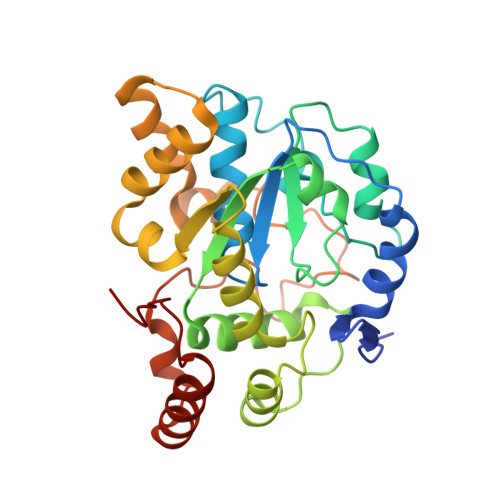Directed evolution of sulfotransferases and paraoxonases by ancestral libraries.
Alcolombri, U., Elias, M., Tawfik, D.S.(2011) J Mol Biol 411: 837-853
- PubMed: 21723874
- DOI: https://doi.org/10.1016/j.jmb.2011.06.037
- Primary Citation of Related Structures:
3QVU, 3QVV - PubMed Abstract:
Large libraries of randomly mutated genes are applied in directed evolution experiments in order to obtain sufficient variability. These libraries, however, contain mostly inactive variants, and the very low frequency of improved variants can only be isolated by high-throughput screening. Small but efficient libraries comprise an attractive alternative. Here, we describe the application of ancestral libraries-libraries based on mutations predicted by phylogenetic analysis and ancestral inference. We designed and constructed such libraries using serum paraoxonases and cytosolic sulfotransferases (SULTs) as model enzymes. Both of these enzyme families exhibit a range of activities in drug metabolism and detoxification of xenobiotics. The ancestral serum paraoxonase and SULT libraries were screened by low-throughput means, including HPLC, using substrates and/or reactions with which all family members exhibit low activity. The libraries showed a remarkably high frequency of highly polymorphic and functionally diverse variants. Screening of as few as 300 variants enabled the isolation of mutants with up to 50-fold higher activity than the starting point enzyme. Structural and kinetic characterizations of an evolved SULT variant show how few ancestral mutations reshaped the active site and modulated the enzyme's specificity. Ancestral libraries therefore comprise a means of focusing diversity to positions and mutations that readily trigger changes in substrate and/or reaction specificity, thereby facilitating the isolation of new enzyme variants for a variety of different substrates and reactions by medium-throughput or even low-throughput screens.
Organizational Affiliation:
Department of Biological Chemistry, Weizmann Institute of Science, Rehovot 76100, Israel.

















